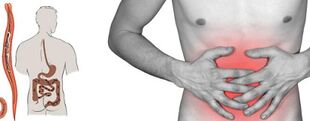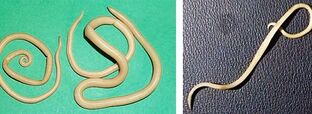
As you know, parasites are considered to be the organisms that are most resistant to the external environment. To date, about 250 species are recognized as helminths capable of infecting humans. All of them threaten the health, and worse, the lives of the infected person. Knowledge of human helminths and their characteristics greatly facilitates treatment and helps to design an effective prevention plan.
What worms do humans have?
It takes a long time to fully get used to the types of worms. In fact, up to now, scientists have not been able to provide the most detailed information about the classification of parasites. This is largely due to the fact that a certain area is characterized by the presence of specific helminthic invasions. In this regard, it is virtually impossible to obtain data on all types of human helminths that exist on Earth.
Thus, the worms, most commonly diagnosed in the southern region, practically do not appear in populations of northern geographic regions. In temperate climates and medium latitudes, about 20 breeds of worms are recognized as the most common. They can be conditionally divided into three main categories:
- Parasitic nematodes (nematodes).
- Tapeworm (cestodes).
- Flattened worms (trematodes).
1. Nematodes and flattened
Each of the groups above contains a large number of parasitic organisms that need a brief description. In children and adults, it is often necessary to treat such representatives of helminths of the helminth class:
- Chinese fluke;
- tapeworm;
- liver fluke.
Among nematodes, there are 7 most common and famous parasitic species that live on the body of all ages. Ringworm is passed through any means possible:
- pinworm
- ; roundworm
- ;
- enteritis;
- coincidentally;
- Trichinella;
- trichostrongylides; hookworm
- .
2. Encryption Invasion
Tapeworms (also known as helminths) are parasitic worms that pose the greatest threat to the body. Diagnosis of such nematode infections is much less common than infestation in children and adults, however, infection with the following types of worms leads to the most severe consequences:
- bovine tapeworm;
- dwarf tapeworm;
- pig tapeworm; wide band
- ;
- echinococcus;
- mouse tapeworm.
One of the rarest invasive helminths is the acanthocephalus. They consist of giant ridges and ridges. Such worms can enter the body in the most rare cases, such as when eating an insect or its larvae infected with a parasite.
Why are worms so dangerous to humans?
In order to fully assess the threat to the health of a patient in the event of a settling of worms, it is necessary first to determine what type of worms they are. Depending on the type of worms, its treatment method and duration is determined. The main harm from the parasite's presence in the body is felt by the intestines - the main part of all worms that are localized in this organ. All nutrients that need to be absorbed and benefit a person are selected by worms.
Whereas other worms do not just settle in the intestines and "steal" all the essential valuable trace elements from humans. They actively reproduce and affect other vital human organs and systems. In addition to the heart muscle, liver and lungs, worms can cause immense damage to the brain and blood vessels. The worms can even infect the eyes.
Major ways of infecting worms

You can protect yourself and your loved ones from the onset of disease if you know how a specific species of helminths enter your body. This is the only way to take all necessary measures in a timely manner and minimize the risk of infection. The main routes of transmission are known already:
- Infection occurs through soil and water. When walking on the ground barefoot, the risk of spawning inside increases many times. Drinking water has not been verified and, under common circumstances, even water from a common water supply can contain worm larvae.
- The helminth eggs enter the body with animal products. The result of worm infestation is inadequate or poor processing of meat, fish, seafood, and eggs. Those who like exotic Asian dishes are at risk of worm infection. Him, sushi, sashimi is made from raw fish and meat.
- Several types of parasites can settle in the intestines, once infected with unwashed fruits and vegetables. Refusal of animal products does not address the potential problem of helminthiasis. As mentioned, worm eggs can be stored in soil. Boiled water should be poured over any fruit before use.
- Worms are transmitted to humans and from animals. Pets are not often the source of infection for their owners. However, worms can be found both inside an animal and on its fur. From dogs and cats, the parasite's eggs fall into the ground, spreading further with dissolved water.
Transmission of the parasite from an infected person
Worms can also travel from one infected person to another. There are several ways of transmission of helminth infestation:
- through unwashed hands (eg when shaking hands, hugging);
- when using common utensils;
- when wearing someone else's underwear;
- group application of some people's personal hygiene products.
Pinworm eggs are usually passed from person to person, they usually fall under the fingernails, staying there for a long time. The popularity of this worm in children is explained by the neglect of the basic rules of clean hygiene. A child can simply put their hands in their mouths or bite their nails, so pinworms are not difficult to enter the body of a new person. The task of parents in this stage is to recognize in time the signs of helminthiasis and prevent the development of helminths from entering the baby's body, immediately starting to treat the disease.
Symptoms of the acute phase of helminthiasis
It is not easy to spot the early signs of parasitic infection in adults or children. Diagnosis of the presence of worms is also complicated because the incubation period in some species can last up to a year and a half.
As a rule, symptoms of worm infection first appear after several periods. In addition, the helminth infection process can be divided into 2 phases:

- acute phase (lasting no more than two months on average after the incubation period); Chronic
- (characterized by the development of sexually mature parasites and can last for decades).
During the acute phase of infiltration, the main symptom, the obvious manifestation can be called an allergic reaction. As a result of the production of antibodies on the migration of parasitic larvae, pathological manifestations of the skin should be warned. Signs of infection with any type of worms in humans are the following symptoms:
- skin congestion;
- burning sensation and itching;
- small rash on the surface of the epidermis or mucous membranes;
- slight increase in lymph nodes;
- local swelling;
- sternum pain (up to suffocation);
- persistent vomiting and nausea;
- diarrhea or constipation.
In addition, dangerous diseases such as pneumonia, meningitis, hepatitis can become complications when other organisms appear in the body.
A reliable confirmation of the presence of helminths in internal organs is the eosinophil index in a clinical blood test. The increased value of these particles is due to a disorder of the blood protein - a violation of the ratio of the normal number between protein fractions.
Types of symptoms in a chronic form of the disease
Signs of chronic helminthiasis in humans are predetermined by the localization of the parasite. In simple terms: the manifestation of the disease will depend on which organs will become the primary habitat of a particular type of worms.
In particular, the most common parasitization in the intestines of roundworms can even proceed without the slightest symptoms. If larger species are affected by worms, signs of the disease become noticeable as soon as the worms reach puberty. Gastrointestinal disturbances in adults and children, pain syndrome and neurotic manifestations are their characteristic features. Roundworm disease is often characterized by the development of intestinal obstruction and pancreatitis, and the risk of cancers increases.
Antiparasitic drugs
It is necessary to treat helminths at the earliest possible stage. An effective remedy would be if you know exactly what type of parasites have settled in the body before starting. Today there are many types of anthelmintic bleaches.
These are different drugs that can target a particular worm. A more powerful worm bleach is a broad spectrum medicine and is great for treating helminthiasis. Both are considered toxic, have a lot of side effects and contraindications. The use of these drugs should be carried out with extreme caution only after medical recommendation.
Most worms in adults require long-term and persistent treatment. Usually, parasitic specialists prescribe concomitant use of several anthelmintic drugs.
The regimen and dosage of a particular drug should be prescribed by a specialist. This will help avoid allergies and serious side effects. For some types of helminth infections, the treatment must be repeated. This is usually because during the first treatment, most of the adult worms are inactivated, but some types of worm larvae and eggs remain in the patient's body. If not treated again, the worms will return again.
Basic precautions
Drug treatment is definitely an important part of the elimination process and, in some cases, the prevention of parasites. However, in order to deal with invasive worms, it is necessary to adhere to the simplest rules for the prevention of worms. The treatment will not work if you ignore the following rules:
- Wash your hands often, especially after using the toilet and before eating.
- If you cannot wash your hands with soap, you should use an antibacterial wet cloth.
- Any food must be thoroughly washed before cooking.
- It is important to expose meat and fish to prolonged heat.
- Use only water from reliable sources for drinking.
- At least once a year, it's extremely important to check for worms.
















































